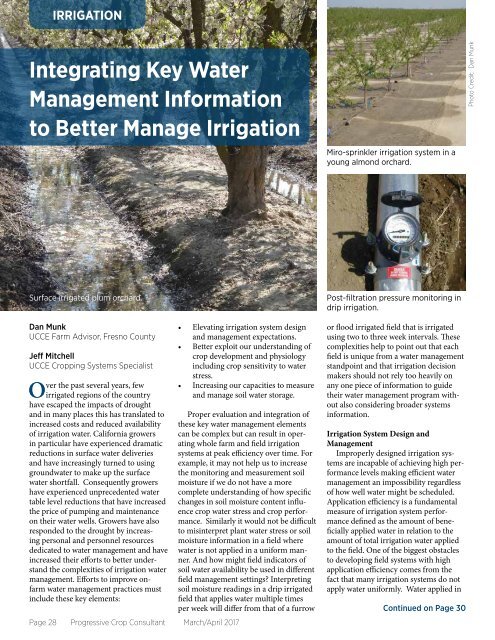Mar_Apr_PCC_2017_Web
You also want an ePaper? Increase the reach of your titles
YUMPU automatically turns print PDFs into web optimized ePapers that Google loves.
IRRIGATION<br />
Integrating Key Water<br />
Management Information<br />
to Better Manage Irrigation<br />
Miro-sprinkler irrigation system in a<br />
young almond orchard.<br />
Photo Credit: Dan Munk<br />
Surface irrigated plum orchard.<br />
Post-filtration pressure monitoring in<br />
drip irrigation.<br />
Dan Munk<br />
UCCE Farm Advisor, Fresno County<br />
Jeff Mitchell<br />
UCCE Cropping Systems Specialist<br />
Over the past several years, few<br />
irrigated regions of the country<br />
have escaped the impacts of drought<br />
and in many places this has translated to<br />
increased costs and reduced availability<br />
of irrigation water. California growers<br />
in particular have experienced dramatic<br />
reductions in surface water deliveries<br />
and have increasingly turned to using<br />
groundwater to make up the surface<br />
water shortfall. Consequently growers<br />
have experienced unprecedented water<br />
table level reductions that have increased<br />
the price of pumping and maintenance<br />
on their water wells. Growers have also<br />
responded to the drought by increasing<br />
personal and personnel resources<br />
dedicated to water management and have<br />
increased their efforts to better understand<br />
the complexities of irrigation water<br />
management. Efforts to improve onfarm<br />
water management practices must<br />
include these key elements:<br />
Page 28 Progressive Crop Consultant <strong>Mar</strong>ch/<strong>Apr</strong>il <strong>2017</strong><br />
• Elevating irrigation system design<br />
and management expectations.<br />
• Better exploit our understanding of<br />
crop development and physiology<br />
including crop sensitivity to water<br />
stress.<br />
• Increasing our capacities to measure<br />
and manage soil water storage.<br />
Proper evaluation and integration of<br />
these key water management elements<br />
can be complex but can result in operating<br />
whole farm and field irrigation<br />
systems at peak efficiency over time. For<br />
example, it may not help us to increase<br />
the monitoring and measurement soil<br />
moisture if we do not have a more<br />
complete understanding of how specific<br />
changes in soil moisture content influence<br />
crop water stress and crop performance.<br />
Similarly it would not be difficult<br />
to misinterpret plant water stress or soil<br />
moisture information in a field where<br />
water is not applied in a uniform manner.<br />
And how might field indicators of<br />
soil water availability be used in different<br />
field management settings? Interpreting<br />
soil moisture readings in a drip irrigated<br />
field that applies water multiple times<br />
per week will differ from that of a furrow<br />
or flood irrigated field that is irrigated<br />
using two to three week intervals. These<br />
complexities help to point out that each<br />
field is unique from a water management<br />
standpoint and that irrigation decision<br />
makers should not rely too heavily on<br />
any one piece of information to guide<br />
their water management program without<br />
also considering broader systems<br />
information.<br />
Irrigation System Design and<br />
Management<br />
Improperly designed irrigation systems<br />
are incapable of achieving high performance<br />
levels making efficient water<br />
management an impossibility regardless<br />
of how well water might be scheduled.<br />
Application efficiency is a fundamental<br />
measure of irrigation system performance<br />
defined as the amount of beneficially<br />
applied water in relation to the<br />
amount of total irrigation water applied<br />
to the field. One of the biggest obstacles<br />
to developing field systems with high<br />
application efficiency comes from the<br />
fact that many irrigation systems do not<br />
apply water uniformly. Water applied in<br />
Continued on Page 30


















